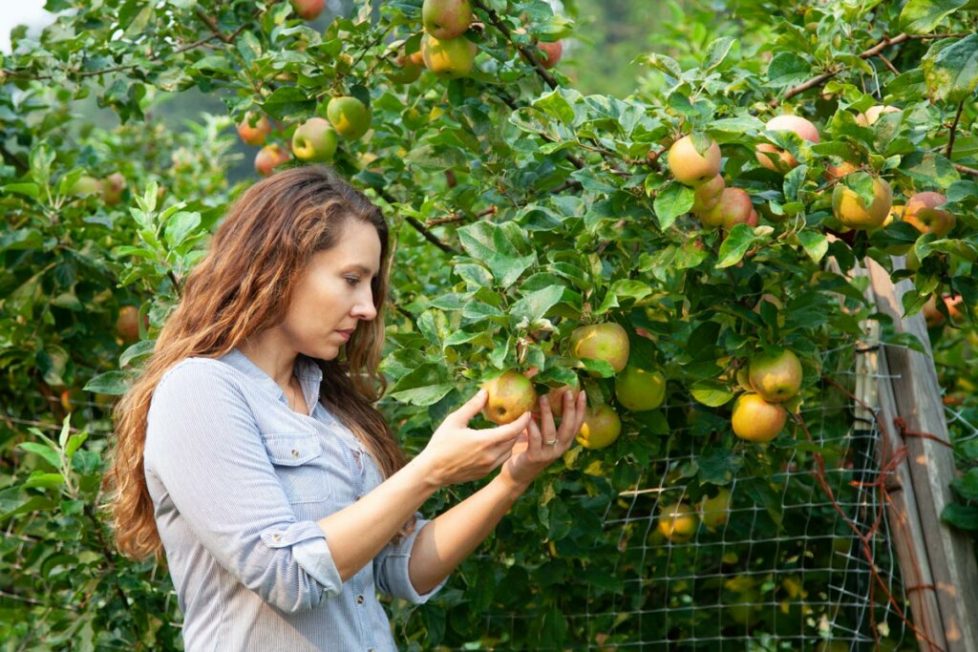How to Prune Apple Trees (Winter or Summer?)

If you have apple trees, knowing how to prune apple trees correctly is critical to the health of your trees and the amount of harvest you’ll receive. Learn how to prune apple trees in winter or if your climate is more suited to summer pruning.
I may be strange, but pruning fruit trees is one of my favorite garden chores each year. It brings me joy to know how I want my fruit trees to look ten years from now, and to create that look through pruning is so rewarding.
If you’re looking to plant an orchard, be sure to read this post on my five tips for starting an orchard first. Then read this post on how to plant a fruit tree.
From there, you’ll want to read the following posts:
Pruning fruit trees is necessary for many reasons.
When fruit trees are pruned incorrectly, quite a bit of harm can be done to the tree resulting in unhealthy or disease-prone trees, less fruit production, or even trees that won’t make it through the winter.
There’s no need to panic, I’ll walk you through every step.
Prune apple trees when they’re dormant, and you have at least two weeks of dry weather after making your pruning cut. Apple trees are pruned in later winter or early spring before the tree begins bud break (when the leaf and fruit buds start to unfurl) in eastern areas of the United States.
However, the best time to prune apple trees in the Pacific Northwest is during the summer when the tree enters into a second dormant phase. You should never prune an apple tree in the fall.
Because your fresh pruning cuts leave the tree susceptible and open to disease, you don’t want to prune when it will be wet for two to three weeks after you prune. Note: ice and snow are considered dry regarding fungus and bacteria spores. In wet parts of the country, like the Pacific Northwest, the best time to prune an apple tree is in July. For more on fruit tree care, read How to Care for Fruit Trees in Fall and Winter.
For years I pruned in late winter and early spring, as you’ll see in the video below, but I learned from a nursery expert that this was likely the reason I was beginning to see some signs of disease in my trees and have now switched to summer pruning only (with the exception of shaping and cutting off dead parts of the tree early spring).
After selecting your pruning time based on climate, it’s important to have proper pruning tools.
It’s important to make the correct type of pruning cuts. Whenever you’re pruning your apple tree, make sure the cut is clean. Choosing the proper pruning tools and keeping them sharp will ensure this.
When removing a full branch, cut the branch right at the collar, close to the trunk. Look at where the branch meets the trunk. Cut straight up and down, right next to the collar, but not into it.
When tipping a branch or cutting out a diseased portion (but not the entire branch), you want to find an outward-facing bud to make your pruning cut. Cut at a 45-degree angle about 1/4 inch away from the bud.
Before pruning, always clean your shears, loppers, and saws with alcohol to avoid spreading any disease between trees and allow them to dry thoroughly before use.
Often I learn best by seeing, so if you’re looking for how to prune apple trees video, I got ya covered below!
Pruning an apple tree is very similar to pruning most fruit trees (peaches, pears, plums, cherries, etc.). The biggest difference is whether you’re allowing a leader branch to grow straight up the middle of the tree or if you’ll create an open canopy with multiple main branches that spread out to create the canopy.
When a tree has been neglected and not pruned for several years, never remove more than 1/3 of the tree. Spread the pruning out over several years to get it fully pruned and back into shape.
When in doubt, take pruning slowly. You can shape and prune your fruit trees over multiple years.
Remember the cuts you made each year and watch how the tree responds. This act of pruning and observing will teach you so much about how to get a fruit tree to the shape you desire and that’s best for your climate.
